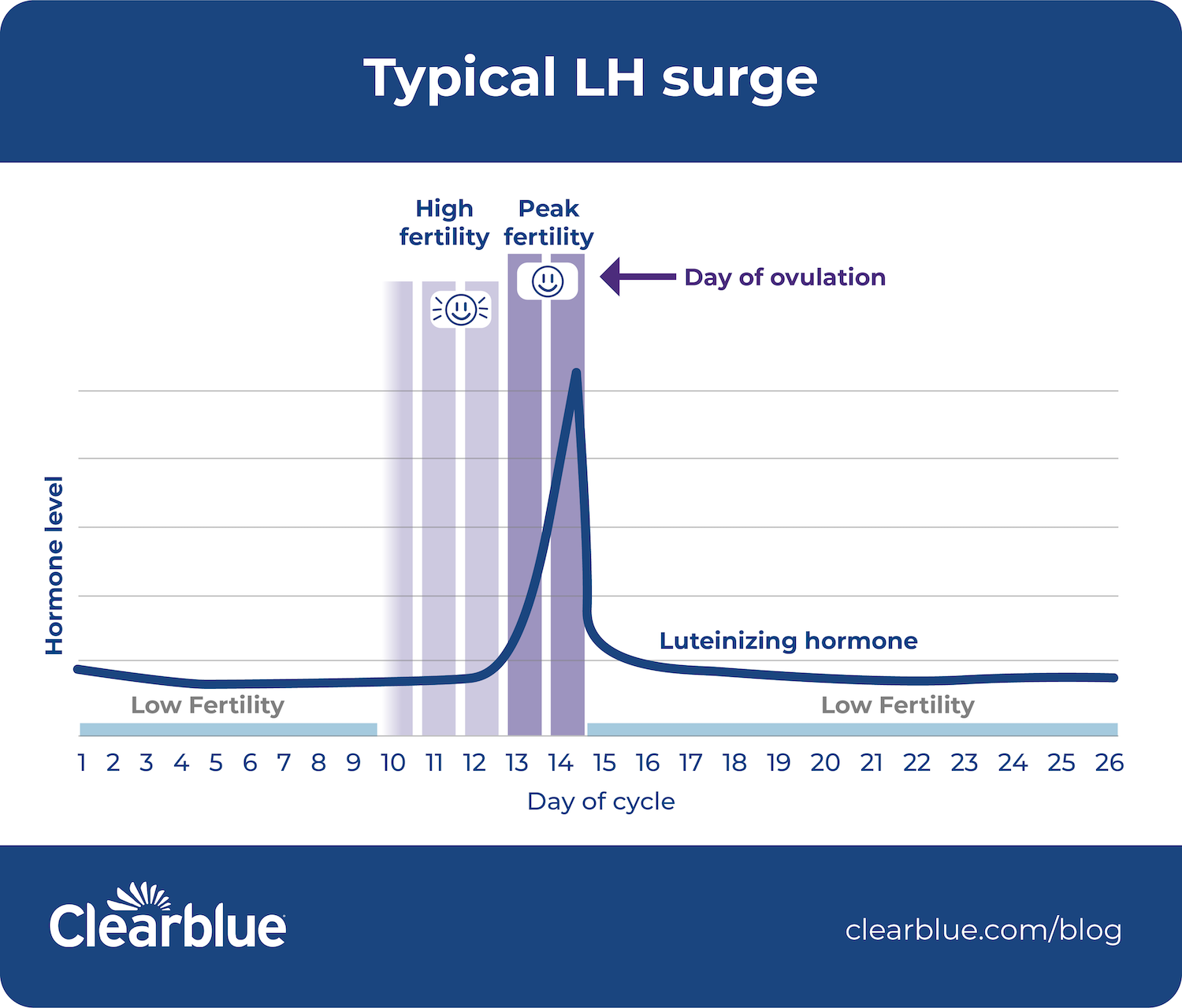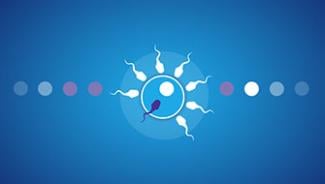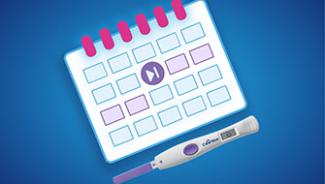What is luteinizing hormone (LH)?

Luteinizing hormone (LH) is a crucial hormone secreted by your pituitary gland that regulates the function of the ovaries, stimulates ovulation and helps support pregnancy.1 Understanding this hormone’s role in reproductive health can help you identify your peak fertility days.
What does luteinizing hormone do?
Throughout your menstrual cycle, the level of LH in your body rises and falls. When the LH concentration surges, the dominant follicle ruptures and releases a mature egg from the ovary (aka ovulation).1 Ovulation occurs 24 to 36 hours after the LH surge.2 After ovulation, the egg can live for up to 24 hours and sperm can survive in the uterus for three to five days. This means that the days leading up to ovulation and the day of ovulation itself are when you’re most fertile — and when you’re most likely to get pregnant. This is why knowing the timing of your LH surge is especially useful if you’re trying to conceive (TTC). You can use ovulation tests, such as Clearblue® Advanced Digital Ovulation Test, to help detect your LH surge.

So, what does LH do during the rest of your cycle?
- In the first half of your menstrual cycle, LH stimulates your ovarian follicles to produce estradiol.3
- When estradiol is high enough, the negative feedback on LH that normally occurs by estrogen is shut off, and it has a positive feedback on LH secretion. This causes an “LH surge,” which initiates ovulation.3
- After ovulation, the ruptured follicle becomes the corpus luteum in your ovary.3 LH stimulates the corpus luteum to produce more progesterone until human Chorionic Gonadotropin (hCG) takes over (if you are pregnant).3 This progesterone will help support a pregnancy if it occurs.3
- If pregnancy doesn’t occur, the corpus luteum breaks down and the levels of estrogen and progesterone decrease.4 Without the high levels of hormones to help maintain it, the thick endometrial lining starts to break down, and your body sheds it.4 This is the start of your period and the beginning of your next menstrual cycle.4
How do LH levels change during your cycle?
At the beginning of your cycle, your LH levels are at their lowest. They start to rise during weeks one and two of your cycle, surge right before ovulation and then decline.1
The following LH levels serve as a general guide, and test results can vary based on your medical history, age, where you are in your menstrual cycle and which lab you use.
How LH levels can vary
- LH levels during the follicular phase: 1.37 to 9 IU/L1
- LH levels before ovulation: 6.17 to 17.2 IU/L1
- LH levels during the luteal phase (after ovulation): 1.09 to 9.2 IU/L1
- LH levels postmenopause: 19.3 to 100.6 IU/L1
Your LH levels also may change in response to health issues or life changes, including fertility issues, irregular periods, perimenopause, menopause or pituitary disorders.1
Your healthcare provider may recommend a series of blood tests to better understand the amount of LH in your blood and how it varies throughout your cycle. Often other hormones are tested at the same time and ultrasounds are sometimes recommended.3,5 Your healthcare provider will recommend which tests will be most useful depending on your personal situation.
Reasons to get your LH levels tested
If you’re trying to conceive, an ovulation test can give you information about your LH surge. However, if you don’t see a surge for three consecutive cycles, this indicates anovulation. It’s a good idea at this point to see your healthcare provider, who might want to do an infertility workup including checking your hormones. There are several reasons your healthcare provider may recommend testing your LH levels, including:
- Infertility: You’re under 35 and have been TTC for 12 months or you’re over 35 and have been trying to conceive for six months. (If you’re over 40, contact your doctor right as you start trying to conceive.)
- Menstrual cycle irregularity: Your periods are irregular. Irregular periods are defined based on the length of the cycle. Periods are considered irregular if there are fewer than 21 days or more than 38 days between cycles.
- No longer having a period: If your periods have stopped, this may indicate you’re in perimenopause or you’re postmenopausal.5
What if my LH levels are low?
Low LH levels could indicate functional hypothalamic amenorrhea (irregular or no periods due to excessive exercise), an eating disorder, issues with your pituitary gland, malnutrition or hyperprolactinemia.1,5,6 Review and discuss your symptoms, as well as the results of your blood test, with your healthcare provider to determine your next steps.
What if my LH levels are high?
High LH levels could signify a problem with your ovaries or anovulation (i.e., when an egg doesn’t release from your ovary), which can make TTC more difficult.5 It probably means you’re not ovulating, which may be due to one of many reasons, such as polycystic ovarian syndrome (PCOS), or low or high body mass index (BMI). High LH levels also may mean you’re in perimenopause or postmenopausal.5 Again, you and your healthcare provider should review and discuss what you’re experiencing, as well as the results of your blood test, and decide what needs to happen next.
Whether you’re TTC or not, LH is an important hormone to consider. Knowing when your LH surge occurs gives you better control of your reproductive health and journey.
Related Articles
Sources
- Cleveland Clinic. Luteinizing hormone. Updated January 8, 2022. Accessed April 26, 2023. https://my.clevelandclinic.org/health/body/22255-luteinizing-hormone
- American Society for Reproductive Medicine. Am I ovulating? Updated 2014. Accessed April 26, 2023. https://www.reproductivefacts.org/news-and-publications/fact-sheets-and-infographics/am-i-ovulating/
- Society for Endocrinology. Luteinising hormone. Updated September 2021. Accessed April 26, 2023. https://www.yourhormones.info/hormones/luteinising-hormone/
- The American College of Obstetricians and Gynecologists. The menstrual cycle: menstruation, ovulation, and how pregnancy occurs. Updated January 2022. Accessed June 28, 2023. https://www.acog.org/womens-health/infographics/the-menstrual-cycle
- MedlinePlus. National Library of Medicine. Luteinizing hormone (LH) levels test. Accessed April 26, 2023. https://medlineplus.gov/lab-tests/luteinizing-hormone-lh-levels-test/
- Endocrine Society. Hyperprolactinemia. Updated January 24, 2022. Accessed June 28, 2023. https://www.endocrine.org/patient-engagement/endocrine-library/hyperprolactinemia

Get pregnant naturally
Ovulation tests are accurate and simple to use.

When to start testing for ovulation?
You'd like to use a Clearblue® Ovulation Test and are wondering when you should start testing? Our tool can help you!




